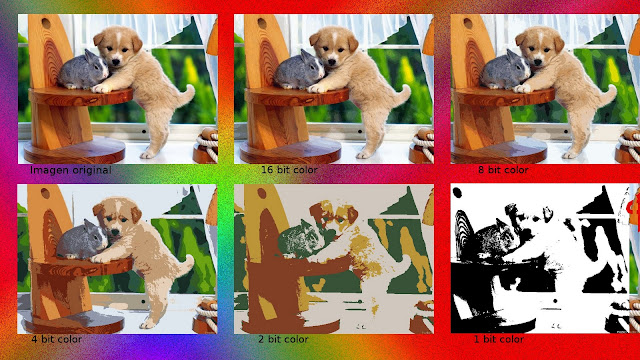- A pixel is the smallest unit of a digital image that can be displayed and represented on a digital display device.
- It is represented by dot (or) square on a display screen.
- These pixel based images are called Bitmap images.
- The physical size of the pixel depends on how we set the resolution for the display screen.
- If we set the display to its maximum resolution, the physical size of a pixel will equal the physical size of a dot pitch of display.
- In the image below, one portion has been magnified many times over so that you can see its individual composition in pixels. As you can see, the pixels approximate the actual image. The more pixels you have, the more closely the image resembles the original.
- Each pixel has a unique logical address.
- Since they are so small, pixels often blend together to form various shades and blends of colors.
Bits per pixel:
- The number of distinct colors that can be represented by a pixel depends on the number of bits per pixel (bpp).
- A 1 bpp image uses 1-bit for each pixel, so each pixel can be either on or off.
- Each additional bit doubles the number of colors available, so a 2 bpp image can have 4 colors, and a 3 bpp image can have 8 colors:
- 1 bpp, 21 = 2 colors (monochrome)
- 2 bpp, 22 = 4 colors
- 3 bpp, 23 = 8 colors
- 8 bpp, 28 = 256 colors
- 16 bpp, 216 = 65,536 colors ("Highcolor" )
- 24 bpp, 224 = 16,777,216 colors ("Truecolor")
- Highcolor, usually meaning 16 bpp, normally has five bits for red and blue each, and six bits for green, as the human eye is more sensitive to errors in green than in the other two primary colors.
- A 24-bit depth allows 8 bits per component. On some systems, 32-bit depth is available: this means that each 24-bit pixel has an extra 8 bits to describe its opacity.
Subpixels:
- Each pixel is actually composed of three dots -- a red, a blue, and a green one.
- A subdivision of a pixel, typically used to show the amounts of red, green or blue separately is called subpixels.
- When the pixel is divided into three subpixels, each subpixel is necessarily rectangular.
For system with subpixels, two different approaches can be taken:
- The subpixels can be ignored, with full-color pixels being treated as the smallest addressable imaging element; or
- The subpixels can be included in rendering calculations, which requires more analysis and processing time, but can produce apparently superior images in some cases.
Megapixel:
- A megapixel is a million pixels, the term is used not only for the number of pixels in an image, but also to express the number of image sensor elements of digital cameras or the number of display elements of digital displays.
- For example, a camera that makes a 2048×1536 pixel image (3,145,728 finished image pixels) typically uses a few extra rows and columns of sensor elements and is commonly said to have "3.2 megapixels".
Disadvantages:
- In terms of the amount of digital storage, bitmaps are memory intensive, and the higher the resolution, the larger the file size.
- When an image is enlarged, the individual coloured squares become visible and the illusion of a smooth image is lost to the viewer. This 'pixelation' makes the image look coarse.






